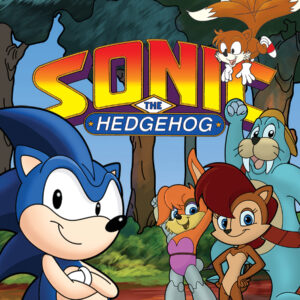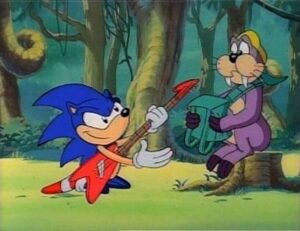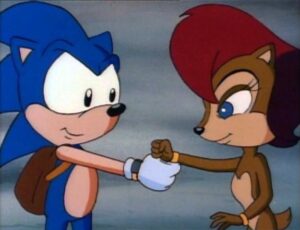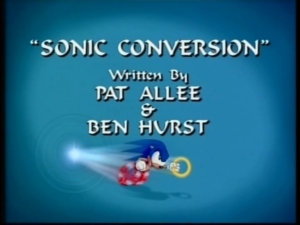in: TV Shows
Sonic the Hedgehog (TV series)
“Sonic the Hedgehog” is an animated TV series produced by DiC Entertainment and the Italian studio Reteitalia, in collaboration with Telecinco. It draws loose inspiration from the video game series of the same name. The show originally aired on ABC from September 18, 1993, to December 3, 1994, setting it apart from another Sonic series, “Adventures of Sonic the Hedgehog,” which premiered in the same month.
In contrast to the bright colors and whimsical humor of “Adventures of Sonic the Hedgehog,” this series, often referred to as “Sonic SatAM” or simply “SatAM” due to its Saturday morning broadcast slot, featured darker storylines, deviating from the tone of the Sonic games of that era. It also served as the basis for the Archie Comics series “Sonic the Hedgehog,” which continued for two decades after the cartoon’s cancellation, featuring many of the same characters.
The show spanned two seasons, with the second season introducing changes like the character Dulcy, alterations to Sally and Rotor’s designs, Robotnik losing his echoing voice, and a somewhat lighter tone. Plans for a third season were in the works, but ABC canceled the show due to low ratings, potentially influenced by competition with FOX Kids’ “Power Rangers.” After its cancellation, reruns of the series were shown on USA Network’s USA Action Extreme Team.
In Canada, the series also aired on CTV Television between the same dates as its ABC run, with an extended run that continued until September 2, 1995, to complete the 1994-1995 broadcast year. The reason for this extended airing might have been to fill the schedule until the end of the broadcast year. Since its cancellation, the show hasn’t been rebroadcast in Canada. In the UK, it initially aired on Channel 4 on Sunday mornings and had recent broadcasts on the Pop and ITV2 channels. In Ireland, the first season aired on RTÉ Two in December 1994.[1]RTÉ Guide. 9-15 December 1994.
Despite its cancellation and limited recent broadcasts, the series maintains a dedicated fanbase on the internet. In response to fan demand, the entire series was released on DVD by Shout! Factory on March 27, 2007. It briefly streamed on Netflix from February 2, 2015, to February 28, 2016.[2]SSF1991 (25 January 2016). SatAM To Leave Netflix On February 28th. TSSZ News. Archived from the original on 18 May 2018. In March 2021, the first season aired on the TA-DAA! channel in Malaysia.
Sonic the Hedgehog
Promotional poster for season two
Development Staff
Genre(s)
- Action-adventure
- Comedy-drama
- Science-fantasy
Directed by
- John Grusd (pilot)
- Dick Sebast (season 1)
- Ron Myrick (season 2)
Produced by
DiC Entertainment
Overview
Broadcast
USA
- ABC (1993-1995)
- USA Network (1995-1996)
- Encore Family (2017-present)
Canada
- CTV (1993-1995)
UK
- Channel MCD (1994-1996)
- POP (2005-2008)
- Kix! (2008-2009)
Ireland
- RTÉ Two (December 1994) (season 1)
Sweden
- TV3 (Viasat) (1995-1998)
Russia
- STS
Turkey
- Maxi TV
France
- TF1 (1995-1996)
- Mangas (2011–present)
- KidsCoTV (2011-2012)
Italy
- Italia 1 (1994)
- Fox Kids (2004)
- Boing (2005)
- Frisbee (2010)
Portugal
- KidsCo TV
Ukraine
- TET (2009)
Argentina
- Magic kids (1996-2000)
Brazil
- Rede Globo (1994-1995)
- SBT (1999-2002)
Chile
- Etc…TV (2012–Present)
Australia
- Network Ten (1993-1999)
- KidsCo
Israel
- Arutz Junior (2012)
Indonesia
- ANTV (1994-1998)[3]Daftar Acara ANTV ANTV Airings list. Wikiwand.
Malaysia
- TV2 (1995-1997)
- TA-DAA! (2021-Present)[4]Astro strengthens kids entertainment with new channel ‘TA-DAA!’ (Ch 612). Astro (12 March 2021). Archived from the original on 15 March 2021. Retrieved on 15 March 2021.
New Zealand
- TV2[note 1]The show was initially broadcast on Sundays at 9am as part of the ‘What Now?’ programming block. However, it was later moved to the 8am time slot.
South Korea
- SBS (1993-1998)
Taiwan
- Disney Channel (1997-?)[5]一直在奔跑:索尼克在中国的二十五年长征路 (Chinese (Simplified)). Zhihu (13 March 2018). Retrieved on 10 April 2023.
Number of Seasons
2
Number of Episodes
26
Development
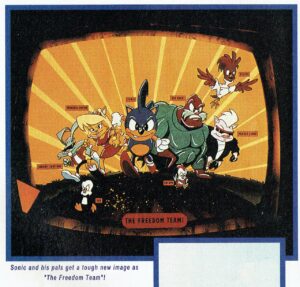
In 1993, an article featured in Sonic the Poster Mag #1, a spin-off of the British Sonic/Sega comic “Sonic the Comic,” which held official licensing from Sega of Europe, revealed the existence of two new Sonic the Hedgehog television series: “Adventures of Sonic the Hedgehog” and “Sonic the Hedgehog.” This article provided a glimpse into these shows through four pages containing plot synopses and concept art. Among these images, there were a few screen shots that stood out, displaying a distinct style and content compared to the rest.[6]Burton, Richard (1993). “It’s Sonic the Hedgehog on TV!“. Sonic the Poster Mag (1). Archived from the original.
These unusual images are believed to be very early concept artworks created for the show, quite possibly as part of a presentation or pitch to Sega. These artworks offer a glimpse into the initial ideas and designs for the series. Notably, one of these images showcases a group referred to as “The Freedom Team.” Interestingly, this image had been previously used (in Sonic the Comic #12) to promote the “Adventures of Sonic the Hedgehog” series, along with another image that shared a similar art style, likely stemming from the same creative period.
What’s striking about these early concept images is the absence of certain characters, most notably Tails. It’s plausible that these concepts were developed before Tails was introduced to the Sonic franchise, explaining his absence in these early artworks.[7]Before SatAM. SonicHQ. Retrieved on 9 January 2007. These images are important artifacts in the history of the Sonic the Hedgehog television series, providing insights into the initial stages of development and the evolution of the show’s characters and themes.
Plot
Main article: List of Sonic the Hedgehog (TV series) episodes
Sonic the Hedgehog unfolds on the planet Mobius during the 33rd century, with specific references to the year 3224 noted in the episode “Blast to the Past, Part 1.” This places the series in the year 3235, a detail also corroborated in the spin-off Archie comic series. The narrative introduces an antagonistic scientist, Dr. Robotnik, along with his robotic chicken companion, Cluck. Together, they launch an invasion and successful conquest of the expansive city of Mobotropolis. Driven by his assistant and nephew, Snively, and aided by a formidable army of robotic soldiers known as Swat-Bots, Robotnik proceeds to transform Mobotropolis into a new urban center, which he dubs Robotropolis. This once-vibrant city is now characterized by pollution, dominated by factories and warehouses.
The invasion event occurs on an ominous Friday the 13th in 3224, with the exact month remaining unspecified, leaving room for speculation that it might have transpired in either September or December of that year, as witnessed in “Blast to the Past, Part 1” and “Part 2.”
Following the capture of Robotnik’s newly conquered realm, he proceeds to seize the royal castle that belonged to the city’s King. The King is subsequently exiled into a dimension known as the Void, while Robotnik converts the castle into his personal headquarters. The rest of the city’s inhabitants, including the intelligent elderly hedgehog Sir Charles Hedgehog and his faithful dog Muttski, fall victim to Robotnik’s sinister plans. He employs a device called the Roboticizer, originally designed by Sir Charles to extend the lifespan of the elderly, to forcibly transform them into enslaved robots.
Those who successfully escaped Robotnik’s oppressive rule sought refuge within the expansive Great Forest, where they established a concealed village aptly named Knothole. This hidden enclave served as their sanctuary, safeguarding them from Robotnik’s watchful eye. United in their struggle for freedom, these survivors organized themselves into a formidable collective known as the Freedom Fighters.
The roster of Freedom Fighters included Sonic the Hedgehog, the spirited and fleet-footed nephew of Charles, effectively assuming the role of leader within the Knothole Freedom Fighters. Sonic’s closest companion was Tails, a young two-tailed fox blessed with the ability to employ his twin tails for flight.
Complementing this dynamic duo were additional Freedom Fighters: Rotor, a mechanically adept walrus; Antoine, a former palace guard and French coyote characterized by numerous personality quirks; and Bunnie Rabbot, a striking Southern cyborg rabbit who had undergone partial roboticization before being rescued by Sonic. Rounding out the leadership of this courageous group was Princess Sally, the sole daughter of the deposed King. Sally was accompanied by Nicole, an advanced sentient mini-computer.
Over a span of ten years, the Freedom Fighters persistently thwarted Robotnik’s relentless schemes and machinations. In the series’ second season, a new addition to the team emerged in the form of Dulcy, a winged female dragon. Dulcy’s backstory was marked by tragedy, as her mother, Sabina, had fallen victim to Robotnik’s nefarious roboticization process, much like the majority of her species.
The series had a run spanning two seasons before it met its untimely cancellation. The concluding episode, titled “The Doomsday Project,” tantalizingly left viewers with a cliff-hanger that hinted at the introduction of a new antagonist for a potential third season. Subsequent revelations unveiled that this new villain would have been none other than Naugus, a sorcerer previously featured in an earlier episode.
Speculation and debates amongst fans and newcomers ensued regarding the mysterious eyes seen in the background during the final episode’s conclusion. Some speculated it might have been Knuckles the Echidna, while others believed it to be the enigmatic Metal Sonic. The semi-official SatAM website provided some clarity when Ben Hurst, a prominent figure associated with the series, confirmed that the eyes indeed belonged to “Ixis Naugus,” definitively dispelling any notions of them belonging to Knuckles or Metal Sonic. However, Hurst did not elaborate on whether Knuckles and Metal Sonic would have played a role in the series had it continued.
Characters
For a full list of the characters in the Sonic the Hedgehog television series, see here.
Main Characters
- Knothole Freedom Fighters
- Sonic the Hedgehog
- Princess Sally
- Bunnie Rabbot
- Rotor
- Antoine Depardieu
- Tails
- Dulcy
- Dr. Robotnik
- Snively
Recurring Characters
- Ari
- Cluck
- Sir Charles “Uncle Chuck” Hedgehog
- Griff
- The King
- Naugus
- Rosie
- Swat-Bots
- Wolf Pack Freedom Fighters
- Lupe
Merchandise
Comic Adaptation
Archie Comics’ Sonic the Hedgehog comic book series adapted two episodes from the “Sonic the Hedgehog” television series. These episodes are:
- “Ghost Busted“: Sonic Super Special #8
- “Cry of the Wolf“: Sonic the Hedgehog #113
Voice Cast
| Voice Actor | Role |
|---|---|
| Jaleel White | Sonic the Hedgehog |
| Kath Soucie | Princess Sally |
| Nicole | |
| Rob Paulsen | Antoine Depardieu |
| Christine Cavanaugh | Bunnie Rabbot |
| William Windom | Sir Charles “Uncle Chuck” Hedgehog |
| Cat | |
| Jim Cummings | Dr. Robotnik |
| Nasty Hyenas | |
| Swat-Bots | |
| Additional voices | |
| Charlie Adler | Snively |
| Cree Summer-Francks | Dulcy |
| Bradley Pierce | Tails |
| Mark Ballou | Rotor (season 1) |
| Cam Brainard | Rotor (season 2) |
| Tahj Mowry | Sonic the Hedgehog (young) |
| Lindsey Ridgeway | Princess Sally (young) |
| Shari Belafonte | Lupe |
| April Winchell | Rosie |
| Dorian Harewood | Ari the Ram |
| Frank Welker | Cluck |
| Swat-Bots | |
| Muttski | |
| Kraken | |
| Terapods | |
| Additional voices | |
| Tim Curry | The King |
| Keeper of the Time Stones | |
| Alaina Reed Hall | Nasty Hyenas |
| Shari Belafonte | Lupe |
| Michael Bell | Naugus |
| Charlie Schlatter | Griff |
| April Winchell | Rosie |
| Ro-Becca | |
| Additional voices | |
| Dorian Harewood | Ari |
| Additional voices | |
| Crystal Cooke | Additional voices |
| David Doyle | |
| Dave Fennoy | |
| Gaille Heidemann | |
| Dana Hill | |
| John Kassir | |
| Katie Leigh | |
| Nancy Linari | |
| Victor Love | |
| Danny Mann | |
| Hal Rayle |
Crew
- Casting director: Marsha Gooodman
- Voice director: Ginny McSwain
Music
The theme song, titled “Sonic the Hedgehog Title,” was penned by Andy Heyward and Robby London, with music composed by Dena Goodmanson and Steven Arbitter.
Reception
Sonic the Hedgehog received mixed reviews from both fans and critics:
Mark Bozon of IGN criticized the show, stating that it hasn’t aged well and falls into the category of “so bad, it’s good.” He compared it to other shows like The Super Mario Bros. Super Show and The Legend of Zelda, suggesting that nostalgia might be the main factor in its appeal.[8]From Captain N to Sonic Underground: Behind videogames’ earliest cartoons. GamesTM. Archived from the original on 14 January 2015.
On the other hand, the show received favorable ratings on TV.com, with mostly positive reviews, earning an 8.3 out of 10 from website voters. IMDB also provided a rating of 6.8 out of 10, based on member reviews.
Patrick Lee of The A.V. Club praised Sonic SatAM for its challenging storylines and the inclusion of elements that were unusual for a Saturday morning cartoon during its time.[9]A hedgehog for all seasons: Our guide to 20 manic years of Sonic cartoons (30 September 2015).
Despite the mixed reviews, the show has developed a dedicated fanbase, with many considering it the best Sonic television series. These fans have expressed support for a potential reboot or the continuation of the series with a third season.
Home Releases
| Image | Title | Format | Description |
|---|---|---|---|
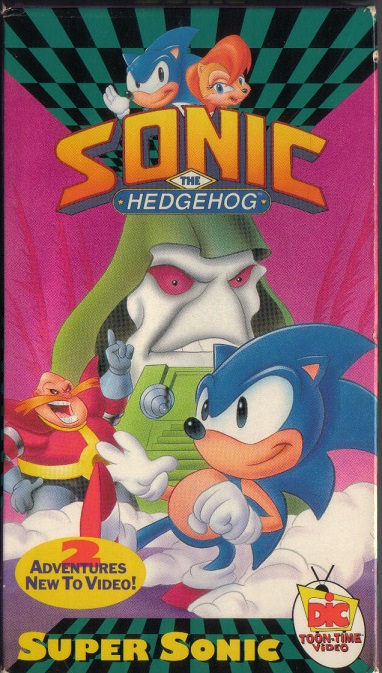 | Super Sonic (1994) | VHS | “Super Sonic” and “Sonic and Sally” |
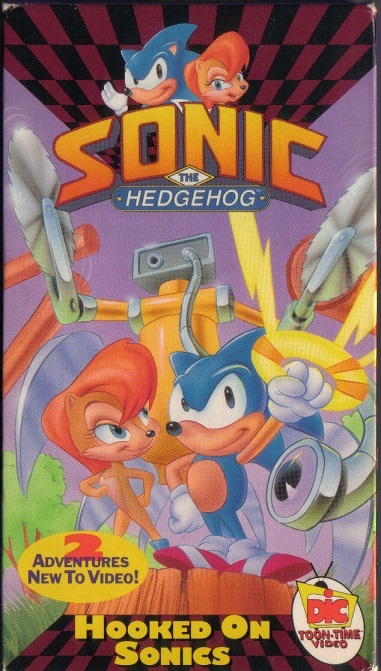 | Hooked on Sonics (21 October 1994) | VHS | “Hooked on Sonics” and “Warp Sonic” |
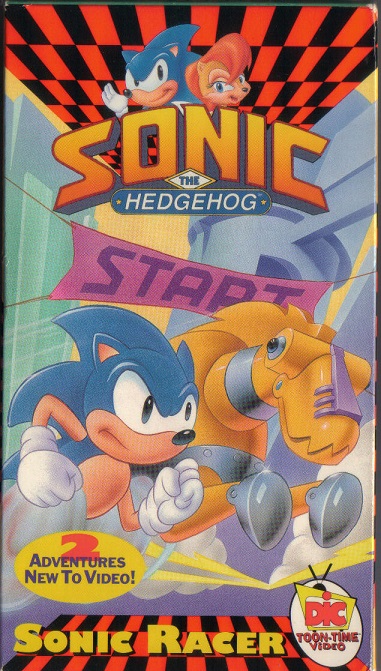 | Sonic Racer (19 December 1994) | VHS | “Sonic Racer” and “Sonic Boom” |
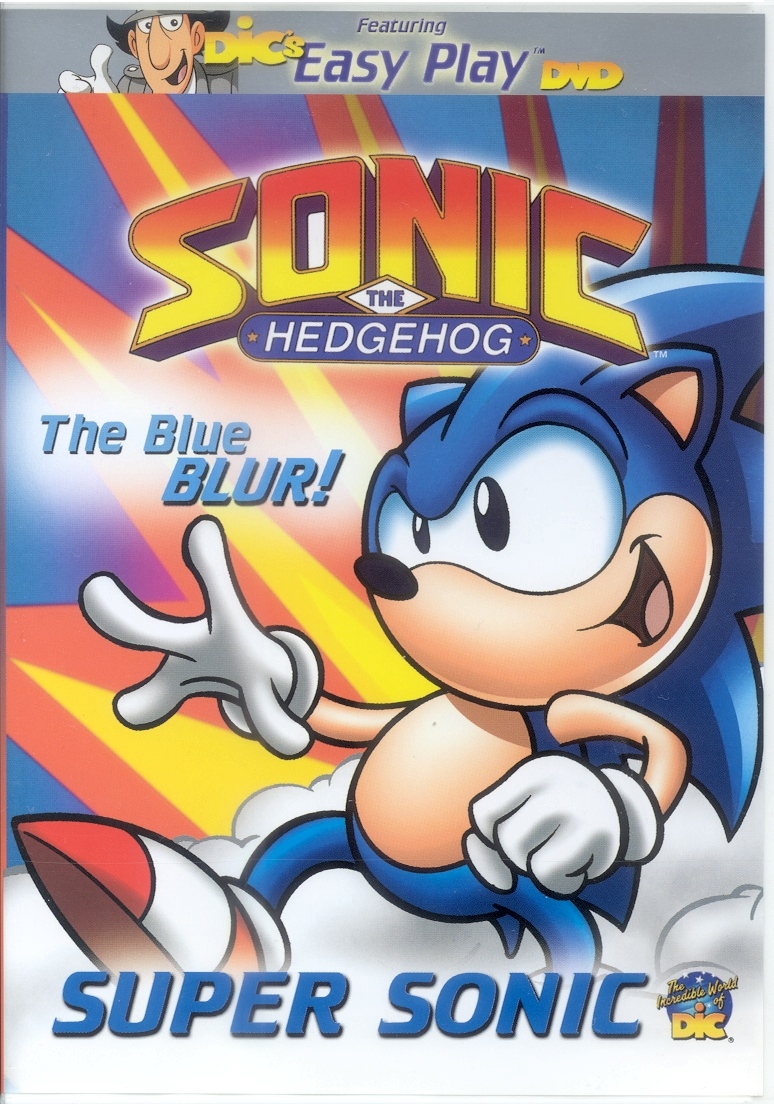 | Super Sonic (26 February 2002) | DVD | “Sonic Boom”, “Sonic and Sally”, “Sonic and the Secret Scrolls”, “Super Sonic”, and “Sonic Racer” |
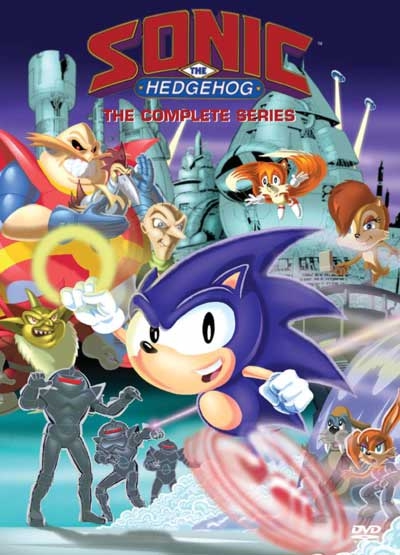 | Sonic the Hedgehog: The Complete Series (27 March 2007) | DVD | Complete series |
Season 3 (Cancelled)
According to writer Ben Hurst, plans for the show’s third season included thirteen episodes, although no scripts were written for this season.
In the planned third season, Snively would briefly take over Robotnik’s position, but his attempts would quickly fail. Snively would be forced to release Naugus (whose eyes were seen behind him at the end of Season 2), The King, and Robotnik from the Void. Naugus would eventually become the main villain, with Robotnik serving as his lackey. Naugus would use The King as bait to lure the Freedom Fighters into a trap. Snively, left with nothing, would temporarily join the Freedom Fighters, only to betray them and be foiled by Antoine. Sally’s father would be recovered but would sacrifice himself into the void to trap Naugus again.
Additionally, Tails would mature and play a larger role as an official member of the Freedom Fighters, even displaying a rebellious side. Dulcy would come into her full powers, and Sally would be romanced by someone other than Sonic, although Sonic would eventually prevail in the end. Sonic himself would undergo a significant character change. Nicole’s backstory would be revealed, explaining that she was once a Mobian child brainwashed into a computer program by Robotnik. At some point, NICOLE would be restored to her former self and become a part of the Freedom Fighters.[10]http://www.sonicsatam.com/information/the-lost-3rd-season/
The backstory of Robotnik and Snively would also be unveiled. They originally came from Earth (Mobius’ past) and attempted to take over a space colony in the year 2200, inadvertently destroying it. They narrowly escaped with their lives and were somehow sent into the distant future, where they returned to Earth, which had become Mobius. Believing himself superior to the sentient animals inhabiting the planet, Robotnik set out to conquer it in any way he could.
Numerous fan attempts have been made to revive the series or create the lost season, but most have failed. The semi-official SatAM page hosts an unofficial webcomic called “Sea3on,” which aims to recreate many of Ben Hurst’s ideas and provide the series with the conclusion it never had. “Sea3on” started in 2009 and is still ongoing.[11]Sea3on.
Sonic Mars
Main article: Sonic Mars
During an interview with Peter Morawiec, a former programmer at Sega Technical Institute and the creator of Comix Zone, it was disclosed that he had worked on a prototype game inspired by the Sonic the Hedgehog cartoon series, following a different game engine compared to the traditional Sonic games. This project would have marked the second instance of characters from the cartoon series appearing in a video game, potentially making it the first appearance of the SatAM versions of Dr. Robotnik and Snively in a game. The intended title for this game was “Sonic Mars,” indicating that it was likely in development for the 32X system, which had the codename “Mars.”
Trivia
- The first episode produced for the show, titled “Heads or Tails,” was actually aired as the 13th and final episode of the first season. It displayed several inconsistencies with the rest of the series, such as variations in character designs, particularly noticeable with Rotor and Sally, who used an earlier design. Furthermore, the characters exhibited different behaviors, the animation featured more vibrant colors, and several audio tracks from “Adventures of Sonic the Hedgehog” were reused.
- Before the show premiered in England, Sonic the Comic (#12, 30 October 1993) showcased images advertising a new Sonic cartoon under the name “Sonic the Hedgehog.” Instead of the Freedom Fighters, this group was named the “Freedom Team” and consisted of all the animals rescued by Sonic in Sonic the Hedgehog (1991). The members included Sonic, Johnny Lightfoot (rabbit), Tux (penguin), Princess Acorn, Joe Sushi (walrus), Chirps (chicken), Porker Lewis (pig), and Flicky (bird). These characters were later used in all the Sonic novels released in the UK, and Johnny and Porker became part of Sonic’s supporting cast in the Sonic the Comic stories.
- This television series has the fewest episodes among all Sonic-related television series. The thirteen episodes from the first season aired on Saturday mornings, coinciding with the sixty-five episodes (excluding the Christmas special) of “Adventures of Sonic the Hedgehog,” which were shown on weekdays.
- Mark Ballou, who voiced one of the characters, left the series voluntarily. He was asked to reprise his role for the second season but opted out at the last minute due to personal reasons. Cam Brainard took his place for the second season. In a later Internet interview, Mark expressed regret for making that choice.
- Snively is the only character in the series to retain “pupil-less” eyes throughout both seasons. Conversely, Sally and Bunnie, who had “pupil-less” eyes in season one, both acquired pupils in season two. Throughout the series, Snively underwent very few changes in appearance, with his gold belt buckle disappearing in season two. His personality also became more pronounced in season two, as he was often more obedient and in the background in season one.
- Rotor was originally going to be named “Boomer” in the series, as per the SatAM Sonic Bible. In his initial appearance in “Heads or Tails,” his fur was purple, and he had a slightly more comical demeanor. In season one, Rotor had grayish-blue fur and a rounder appearance than in “Heads or Tails.” During season two, Rotor became a secondary character, had slightly different attire, his fur was dark blue, and he had less screen time and action. Consequently, Rotor is one of the few characters to undergo many changes in both appearance and role.
- Robotnik’s roboticized pet bird, Cluck, appeared in only nine episodes of season one and was neither mentioned nor seen in season two. Sonic and Sally are the only characters to appear in every episode of the series.
- Strangely, season two was never aired in Spain. In the Middle East, scenes depicting romance were entirely edited out due to federal laws against on-screen intimacy in MENA regions.
- Some mistakenly believe that this series served as the basis for the long-running Archie Sonic the Hedgehog comics. However, it was the other way around; the comic derived ideas from this series while it was still in production. Developing an animated cartoon takes longer than creating a comic.
- Notably, this series was the first Sonic the Hedgehog television series to feature a theme song with lyrics.
Archive Links




Notes
- ↑ The show was initially broadcast on Sundays at 9am as part of the ‘What Now?’ programming block. However, it was later moved to the 8am time slot.
References
- ↑ RTÉ Guide. 9-15 December 1994.
- ↑ SSF1991 (25 January 2016). SatAM To Leave Netflix On February 28th. TSSZ News. Archived from the original on 18 May 2018.
- ↑ Daftar Acara ANTV ANTV Airings list. Wikiwand.
- ↑ Astro strengthens kids entertainment with new channel ‘TA-DAA!’ (Ch 612). Astro (12 March 2021). Archived from the original on 15 March 2021. Retrieved on 15 March 2021.
- ↑ 一直在奔跑:索尼克在中国的二十五年长征路 (Chinese (Simplified)). Zhihu (13 March 2018). Retrieved on 10 April 2023.
- ↑ Burton, Richard (1993). “It’s Sonic the Hedgehog on TV!“. Sonic the Poster Mag (1). Archived from the original.
- ↑ Before SatAM. SonicHQ. Retrieved on 9 January 2007.
- ↑ From Captain N to Sonic Underground: Behind videogames’ earliest cartoons. GamesTM. Archived from the original on 14 January 2015.
- ↑ A hedgehog for all seasons: Our guide to 20 manic years of Sonic cartoons (30 September 2015).
- ↑ http://www.sonicsatam.com/information/the-lost-3rd-season/
- ↑ Sea3on.
External Links
- Sonic the Hedgehog at Saturday Morning Sonic
- Sonic the Hedgehog at the Knothole Express (archived)
- Sonic the Hedgehog at Wikipedia, the free encyclopedia
Related Articles
Related Posts
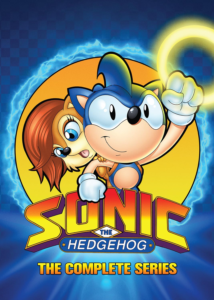
Sonic SatAM Returns with a New DVD Box Set
July 11, 2023 3:48 amGet ready, Freedom Fighters! The beloved DiC animated series Sonic the Hedgehog, also known as Sonic SatAM, is making its long-awaited
READ MORE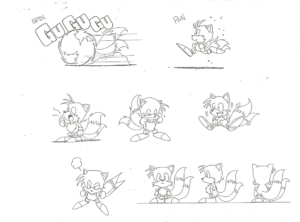
Early, Never Before Seen Tails Concept Art Discovered From Sonic SatAM TV Show Pilot
April 12, 2023 8:59 amEarly, never before seen Tails concept art discovered from Sonic SatAM TV show pilot Content: Twitter user @PlaceandH (Fieryfurnace)
READ MORE

